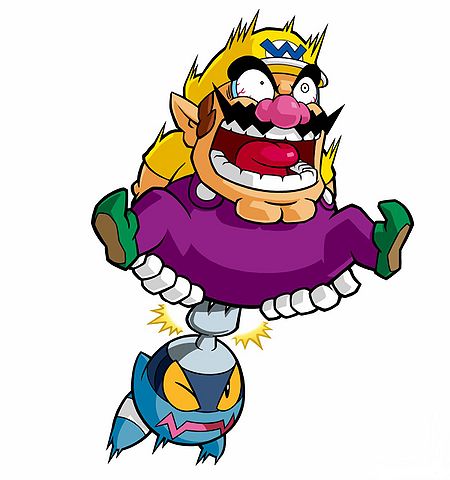Wario Land: Shake Dimension – Mechanics
April 2nd, 2013
To wit, Wario Land: Shake Dimension takes Wario Land 4, pairs back or removes the mechanics, transformations, and game elements to a sort of proto-Wario Land 1 state and then replaces all the nuance and dynamics that made Wario Land 4 engaging with gestures that don’t evolve beyond their base level application. That’s not to jump on the “motion controls ruin everything, boo, hoo, hoo” bandwagon. In this case, the gameplay concepts themselves aren’t expanded beyond the player shaking the remote to make Wario do a particular action. The folded level design also isn’t so crash hot either, and the game has a nasty habit of making it easy for the player to fail optional challenges (often listed as side objectives, for the compulsive) and then denying them a retry, something which encourages manual restarts. Shake Dimension is a bare bones Wario game to say the least. Let’s extend on this a little though:
Mechanics
Wario’s core ability set is identical to Super Mario Land 3: Wario Land, except that the player can turn the Wii-mote to angle throws and shake the Wii-mote to shake a held object or activate an Earthshake Punch. Shaking a held object can cause coins or other treats to come bouncing out of them. The Earthshake Punch has Wario punch the ground, stunning enemies and altering certain level elements. The mechanic’s similar to Wario Land 4‘s heightened smash attack (level 2 quake), but can be activated instantly and runs on a cool down meter.
The Earthshake Punch and shaking held objects aren’t very engaging mechanics: the player waggles the controller and Wario does the action, that’s it. Although the mechanics are intuitive, as the input matches the output (shaking), there’s no variability to the motion. So, Wario can’t not do an Earthshake Punch because the player didn’t shake the controller hard enough, for example. Furthermore, the player can’t charge the mechanics like Wario Land 4‘s smash attack (ground pound), frame cut like Wario Land 4‘s attack jump, or activate frame-specific moves like Wario Land 4‘s dash attack.
Many of Wario’s mechanics are allocated to specific game elements. It’s these game elements that make up the majority of gameplay concepts—as opposed to the transformations in Wario Land 4, which are extremely paired back in Shake Dimension. These devices make clever use of the Wii-mote’s accelerometer and are much more engaging than the two permanent, motion-controlled mechanics. The unibuckets, for example, accelerate sharply when the Wii-mote is tilted, so the player must work against this nuance so as not to oversteer (more examples in the image above). I’m not so convinced of the Subwarine, though, which is fiddly and unnatural. Best to leave the submarining to Mario.
When Wario enters a red, right-angled pipe, officially called a Max Fastosity Dasherator, he can dash attack. Shake Dimension‘s dash attack is modelled after Wario Land 4‘s, but there are two significant differences:
- The player can’t end the mechanic at will, Wario must hit a wall, instead.
- Wario can change direction mid-dash, resulting in a short skid which sees him moving in the direction he was travelling for a few pixels.
These changes put a stress on the player keeping the dash attack active over an extended distance, where they can make the most of its fast speed. The folded level design and reward-based sub-objectives play into this, hiding the best rewards where only a dash attacking Wario can reach, at the end of the post-fold. This is also true of the time-based sub-objectives, which can only be met by completing most of the post-fold with the dash attack. The ability to change direction allows for more latitude in the level arrangements and plays into the mechanic’s skid nuance.
As for the other differences between Shake Dimension and its predecessor:
- The throw mechanic’s charge time is shorter, to the point that you can’t do a regular throw.
- Wario slides down slopes on his stomach. The animation ends after a set distance.
- Wario can only swim on the surface of water, left or right.
- Wario can aim his throws with the Wii-mote. Snappy and responsive game feel.
- The Wii-mote’s d-pad is made of hard plastic with sharp edges (at least for a game controller), so it’s not as comfortable to control Wario.
This is a two-parter, so stick around for part #2 where I discuss Shake Dimension‘s enemies, rewards, level design, and progression structure.





 Game Design Companion: A Critical Analysis of Wario Land 4 - $7.99
Game Design Companion: A Critical Analysis of Wario Land 4 - $7.99 Level Design: Processes and Experiences
Level Design: Processes and Experiences Speed Boost: The Hidden Secrets Behind Arcade Racing Design - $5.99
Speed Boost: The Hidden Secrets Behind Arcade Racing Design - $5.99 Adventures in Games Analysis: Volume I - $5.99
Adventures in Games Analysis: Volume I - $5.99







